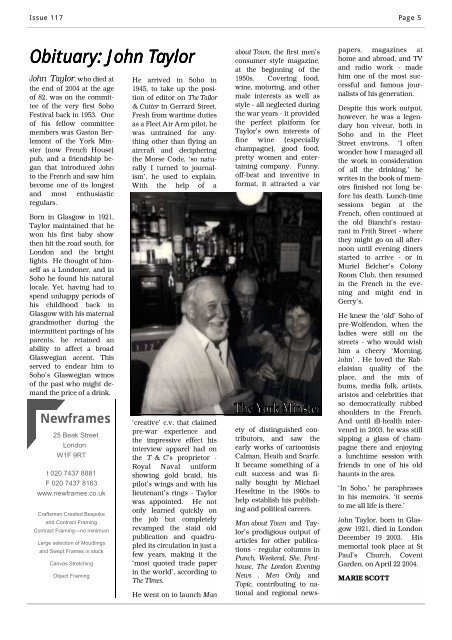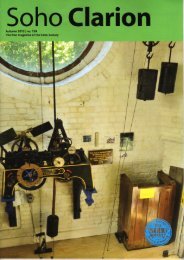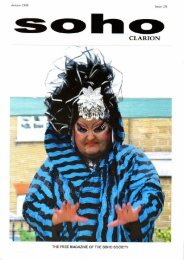soho clarion - The Soho Society
soho clarion - The Soho Society
soho clarion - The Soho Society
Create successful ePaper yourself
Turn your PDF publications into a flip-book with our unique Google optimized e-Paper software.
Issue 117 Page 5<br />
Obituary: Obituary: John John Taylor<br />
Taylor<br />
John Taylor, who died at<br />
the end of 2004 at the age<br />
of 82, was on the committee<br />
of the very first <strong>Soho</strong><br />
Festival back in 1953. One<br />
of his fellow committee<br />
members was Gaston Berlemont<br />
of the York Minster<br />
(now French House)<br />
pub, and a friendship began<br />
that introduced John<br />
to the French and saw him<br />
become one of its longest<br />
and most enthusiastic<br />
regulars.<br />
Born in Glasgow in 1921,<br />
Taylor maintained that he<br />
won his first baby show<br />
then hit the road south, for<br />
London and the bright<br />
lights. He thought of himself<br />
as a Londoner, and in<br />
<strong>Soho</strong> he found his natural<br />
locale. Yet, having had to<br />
spend unhappy periods of<br />
his childhood back in<br />
Glasgow with his maternal<br />
grandmother during the<br />
intermittent partings of his<br />
parents, he retained an<br />
ability to affect a broad<br />
Glaswegian accent. This<br />
served to endear him to<br />
<strong>Soho</strong>’s Glaswegian winos<br />
of the past who might demand<br />
the price of a drink.<br />
Newframes<br />
25 Beak Street<br />
London<br />
W1F 9RT<br />
t 020 7437 8881<br />
F 020 7437 8163<br />
www.newframes.co.uk<br />
Craftsmen Created Bespoke<br />
and Contract Framing<br />
Contract Framing—no minimum<br />
Large selection of Moudlings<br />
and Swept Frames in stock<br />
Canvas Stretching<br />
Object Framing<br />
He arrived in <strong>Soho</strong> in<br />
1945, to take up the position<br />
of editor on <strong>The</strong> Tailor<br />
& Cutter in Gerrard Street.<br />
Fresh from wartime duties<br />
as a Fleet Air Arm pilot, he<br />
was untrained for anything<br />
other than flying an<br />
aircraft and deciphering<br />
the Morse Code, ‘so naturally<br />
I turned to journalism’,<br />
he used to explain.<br />
With the help of a<br />
‘creative’ c.v. that claimed<br />
pre-war experience and<br />
the impressive effect his<br />
interview apparel had on<br />
the T & C’s proprietor -<br />
Royal Naval uniform<br />
showing gold braid, his<br />
pilot’s wings and with his<br />
lieutenant’s rings - Taylor<br />
was appointed. He not<br />
only learned quickly on<br />
the job but completely<br />
revamped the staid old<br />
publication and quadrupled<br />
its circulation in just a<br />
few years, making it the<br />
‘most quoted trade paper<br />
in the world’, according to<br />
<strong>The</strong> Times.<br />
He went on to launch Man<br />
about Town, the first men’s<br />
consumer style magazine,<br />
at the beginning of the<br />
1950s. Covering food,<br />
wine, motoring, and other<br />
male interests as well as<br />
style - all neglected during<br />
the war years - it provided<br />
the perfect platform for<br />
Taylor’s own interests of<br />
fine wine (especially<br />
champagne), good food,<br />
pretty women and entertaining<br />
company. Funny,<br />
off-beat and inventive in<br />
format, it attracted a var<br />
ety of distinguished contributors,<br />
and saw the<br />
early works of cartoonists<br />
Calman, Heath and Scarfe.<br />
It became something of a<br />
cult success and was finally<br />
bought by Michael<br />
Heseltine in the 1960s to<br />
help establish his publishing<br />
and political careers.<br />
Man about Town and Taylor’s<br />
prodigious output of<br />
articles for other publications<br />
- regular columns in<br />
Punch, Weekend, She, Penthouse,<br />
<strong>The</strong> London Evening<br />
News , Men Only and<br />
Topic, contributing to national<br />
and regional news-<br />
papers, magazines at<br />
home and abroad, and TV<br />
and radio work - made<br />
him one of the most successful<br />
and famous journalists<br />
of his generation.<br />
Despite this work output,<br />
however, he was a legendary<br />
bon viveur, both in<br />
<strong>Soho</strong> and in the Fleet<br />
Street environs. ‘I often<br />
wonder how I managed all<br />
the work in consideration<br />
of all the drinking,’ he<br />
writes in the book of memoirs<br />
finished not long before<br />
his death. Lunch-time<br />
sessions began at the<br />
French, often continued at<br />
the old Bianchi’s restaurant<br />
in Frith Street - where<br />
they might go on all afternoon<br />
until evening diners<br />
started to arrive - or in<br />
Muriel Belcher’s Colony<br />
Room Club, then resumed<br />
in the French in the evening<br />
and might end in<br />
Gerry’s.<br />
He knew the ‘old’ <strong>Soho</strong> of<br />
pre-Wolfendon, when the<br />
ladies were still on the<br />
streets - who would wish<br />
him a cheery ‘Morning,<br />
John’ . He loved the Rabelaisian<br />
quality of the<br />
place, and the mix of<br />
bums, media folk, artists,<br />
aristos and celebrities that<br />
so democratically rubbed<br />
shoulders in the French.<br />
And until ill-health intervened<br />
in 2003, he was still<br />
sipping a glass of champagne<br />
there and enjoying<br />
a lunchtime session with<br />
friends in one of his old<br />
haunts in the area.<br />
‘In <strong>Soho</strong>,’ he paraphrases<br />
in his memoirs, ‘it seems<br />
to me all life is there.’<br />
John Taylor, born in Glasgow<br />
1921, died in London<br />
December 19 2003. His<br />
memorial took place at St<br />
Paul’s Church, Covent<br />
Garden, on April 22 2004.<br />
MARIE SCOTT




